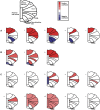Structural cerebellar correlates of cognitive and motor dysfunctions in cerebellar degeneration
- PMID: 28043955
- PMCID: PMC5837314
- DOI: 10.1093/brain/aww327
Structural cerebellar correlates of cognitive and motor dysfunctions in cerebellar degeneration
Abstract
See King et al. (doi:10.1093/aww348) for a scientific commentary on this article.Detailed mapping of clinical dysfunctions to the cerebellar lobules in disease populations is necessary to establish the functional significance of lobules implicated in cognitive and motor functions in normal subjects. This study constitutes the first quantitative examination of the lobular correlates of a broad range of cognitive and motor phenomena in cerebellar disease. We analysed cross-sectional data from 72 cases with cerebellar disease and 36 controls without cerebellar disease. Cerebellar lobule volumes were derived from a graph-cut based segmentation algorithm. Sparse partial least squares, a variable selection approach, was used to identify lobules associated with motor function, language, executive function, memory, verbal learning, perceptual organization and visuomotor coordination. Motor dysfunctions were chiefly associated with the anterior lobe and posterior lobule HVI. Confrontation naming, noun fluency, recognition, and perceptual organization did not have cerebellar associations. Verb and phonemic fluency, working memory, cognitive flexibility, immediate and delayed recall, verbal learning, and visuomotor coordination were variably associated with HVI, Crus I, Crus II, HVII B and/or HIX. Immediate and delayed recall also showed associations with the anterior lobe. These findings provide preliminary anatomical evidence for a functional topography of the cerebellum first defined in task-based functional magnetic resonance imaging studies of normal subjects and support the hypotheses that (i) cerebellar efferents target frontal lobe neurons involved in forming action representations and new search strategies; (ii) there is greater involvement of the cerebellum when immediate recall tasks involve more complex verbal stimuli (e.g. longer words versus digits); and (iii) it is involved in spontaneous retrieval of long-term memory. More generally, they provide an anatomical background for studies that seek the mechanisms by which cognitive and motor dysfunctions arise from cerebellar degeneration. Beyond replicating these findings, future research should employ experimental tasks to probe the integrity of specific functions in cerebellar disease, and new imaging methods to quantitatively map atrophy across the cerebellum.
Keywords: brain atrophy; cerebellar function; cognitive control; motor control; structural MR imaging.
© The Author (2016). Published by Oxford University Press on behalf of the Guarantors of Brain. All rights reserved. For Permissions, please email: journals.permissions@oup.com.
Figures



Comment in
-
Towards a multi-function mapping of the cerebellar cortex.Brain. 2017 Mar 1;140(3):522-524. doi: 10.1093/brain/aww348. Brain. 2017. PMID: 28364553 No abstract available.
References
-
- Acharjee A, Finkers R, Visser R, Maliepaard C. Comparison of regularized regression methods for ∼Omics data. Metabolomics 2013; 3: 126.
-
- Akshoomoff NA, Courchesne E. A new role for the cerebellum in cognitive operations. Behav Neurosci 1992; 106: 731–738. - PubMed
-
- Akshoomoff NA, Courchesne E. ERP evidence for a shifting attention deficit in patients with damage to the cerebellum. J Cogn Neurosci 1994; 6: 388–99. - PubMed
-
- Baddeley A. Working memory and language: an overview. J Commun Disord 2003a; 36: 189–208. - PubMed
Publication types
MeSH terms
Grants and funding
LinkOut - more resources
Full Text Sources
Other Literature Sources
Medical

